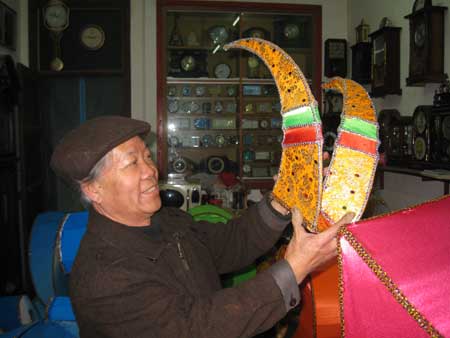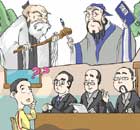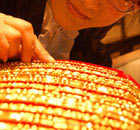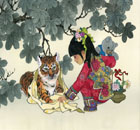Profiles
Old traditions for the New Year
By Guo Rui (China Daily)
Updated: 2010-02-10 07:07
 |
Large Medium Small |
Artist keeps ancient crafts alive for the love of art, not for money
WUHAN: Like millions of people in China and around the world, Liu Niba is preparing for Chinese New Year. But Liu's preparations are a little different.
For nearly 30 years, this renowned folk artist has been busy at his workshop near the port city of Wuhan in central China's Hubei province, supervising his craftsmen as they create the colorful paper and wire-framed creatures and bright lanterns that are the mainstays of Chinese New Year celebrations.
|
 Folk artist Liu Niba shows his works at his home and workshop near Wuhan, capital of central China's Hubei province. [Photo\Guo Rui] |
Some are large dragons that stretch for over 100 m and are manned by many people, while others are more modest in size but just as dazzling. For Liu, his annual New Year celebrations are a labor of love for which he receives no financial support.
One's first impression of Liu is his quiet and unpretentious demeanor.
Contrary to what some may believe, his name Niba, meaning 'mud', is not an artistic nickname, but was given to him when plain names were thought to make growing up smoother for a child.
His smooth, unlined face and bright eyes are those of a man much younger than his 63 years. Only his hands show the scars of over half a century of painstaking hand craftsmanship.
Although he has twice been to Europe on Chinese government sponsored tours, and has a photo with former French president Jacques Chirac on display in his studio, Liu is modest and humble, and eager to share his passion for his art with visitors.
To prepare for this year's Spring Festival lantern show, Liu starts his work at 2 am every day and does not stop until 9 pm. He works most days alone in the two rooms of his workshop, surrounded by his clock collection and his own works of art.
When asked if he feels lonely, his answer is simple: "The duty of the artist is to persevere."
A self-taught artist, he never imagined he would find himself in this career when he was young.
"When I was 10, my sister was ready to get married and my parents purchased a clock as her dowry," Liu said.
Unfortunately it broke before the wedding, so Liu took it to get repaired. However, the clock broke again when Liu was on his way home. The little boy was so scared of being blamed by his parents he reassembled it himself. Surprisingly, it worked.
"I found I had a talent to manipulate objects," Liu said.
The skill may also have been inherited. Liu's father was a plain but hard-working carpenter who always told his five children to be diligent so they could avoid starvation, as food was in short supply in the 1940s.
Later, during the "cultural revolution" (1966-76), Liu was sent to work at the Wuhan Iron and Steel Corporation.
"The paper and ink were all free, so I made good use of them to practice my calligraphy, and I made great progress those days," he said giggling.
Although he works with different materials, Liu's specialties are wooden miniatures and paper cutting.
The miniatures, about the size of a fingernail, are made of as many as 41 pieces of alternating light and dark sandalwood meticulously assembled into tiny bowls, barrels and buckets held together by thread. His paper cuttings of traditional Chinese subjects such as flowers and tigers have been sold in Europe for around 40 to 50 yuan ($6-7) each.
But what about his clock collection?
Liu's art is beyond time, but he is surrounded by many "keepers of the time". When asked, he said each of the clocks in his collection - from the noblest and most exquisite of grandfather clocks to humble mass-produced kitchen and bedroom alarm clocks - tells a story reflecting the era in which it was made.
Liu said his great wish now is to build a Chinese folk art museum. However, it may cost as much as one million yuan.
Liu said he never got official sponsorship except for 1,000 yuan when he won the title of Wuhan Folk Artist. These years he often borrows money from his three children when he is out of money.
For the lantern show during Spring Festival, Liu has employed a dozen workers, most of them neighbors, and pays them an average 100 yuan a day plus meals. Add to that the cost of material like iron, colorful corduroy and so on.
"I do this not for money or fame, but for the promotion of traditional culture. If we folk artists don't do this, you and your future generations will forget all about it."
As he grows older and the time left to create art becomes shorter, Liu hopes that his granddaughter, now about the age he was when he started his career, will carry on the tradition, so his timeless art will continue on in a rapidly changing China.







